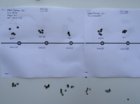dcali
Bullet Maker
I think a lot of shooters have trouble with ladders because they do it the hard way - they measure out ten or so different charge weights, shoot them all at the same target, and then try to visually discern where vertical is tight.
The better way to do it is to shoot maybe 20-30 shots over that same charge range and note the exact velocity and height above or below center of each shot. This is pretty easy with a shotmarker, but a ruler will do.
If you then plot shot height vs velocity you get something like this (the y axis is millimeters above or below an arbitrary point on the target, x axis is fps). In this case, it's worth noting a few things.
- this was shot at 600 yards on a calm day.
- the velocity became very inconsistent at high charges. I believe hat's what's going on at the far right end - the rifle just falls apart with too hot a load.
- The line levels out at around 2615 fps.
- the charge weight is not relevant to the ladder. You just want to target the right velocity, and then back out a charge weight. In this case, that's about 2630, which worked out to 44.0 grains of Varget.
- the numbers are messy. You aren't going to get perfect numbers, but you can tell that there is no node below 2615 or so
- in this case, the tightest SD was also around 44.0 grains. I'm not sure if that's a coincidence or not.
- it is entirely possible to shoot a ladder and not find a node.
- ballistics only account for 100mm of the roughly 300mm of vertical. That's 200mm of tune.

The better way to do it is to shoot maybe 20-30 shots over that same charge range and note the exact velocity and height above or below center of each shot. This is pretty easy with a shotmarker, but a ruler will do.
If you then plot shot height vs velocity you get something like this (the y axis is millimeters above or below an arbitrary point on the target, x axis is fps). In this case, it's worth noting a few things.
- this was shot at 600 yards on a calm day.
- the velocity became very inconsistent at high charges. I believe hat's what's going on at the far right end - the rifle just falls apart with too hot a load.
- The line levels out at around 2615 fps.
- the charge weight is not relevant to the ladder. You just want to target the right velocity, and then back out a charge weight. In this case, that's about 2630, which worked out to 44.0 grains of Varget.
- the numbers are messy. You aren't going to get perfect numbers, but you can tell that there is no node below 2615 or so
- in this case, the tightest SD was also around 44.0 grains. I'm not sure if that's a coincidence or not.
- it is entirely possible to shoot a ladder and not find a node.
- ballistics only account for 100mm of the roughly 300mm of vertical. That's 200mm of tune.

Last edited:











